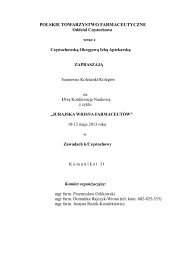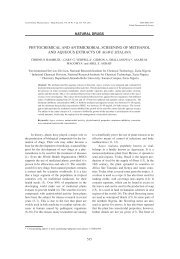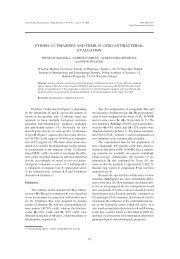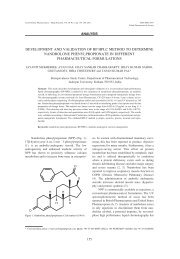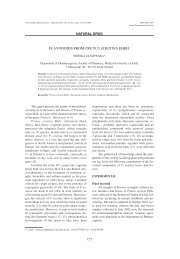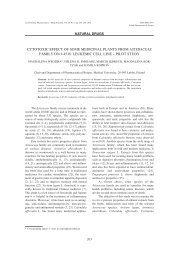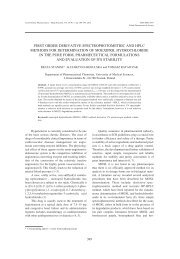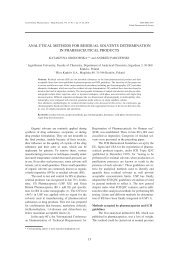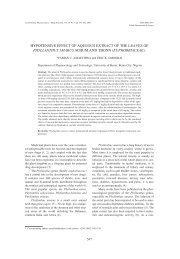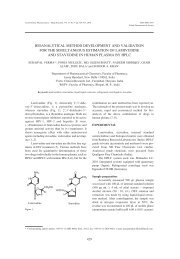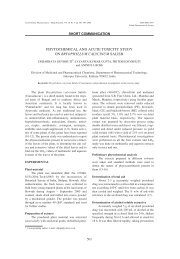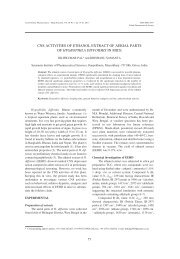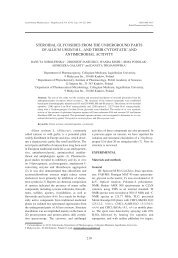Evaluation of anti-compulsive effect of methanolic extract
Evaluation of anti-compulsive effect of methanolic extract
Evaluation of anti-compulsive effect of methanolic extract
Create successful ePaper yourself
Turn your PDF publications into a flip-book with our unique Google optimized e-Paper software.
418 SHIKHA GIRDHAR et al.<br />
peeled <strong>of</strong>f and seeds were removed. Pulp was<br />
mashed using an electric juicer to afford a s<strong>of</strong>t mass<br />
and later on macerated with methanol (1 : 4) for<br />
seven days at room temperature with occasional stirring<br />
daily. On eighth day, the pulp mass was filtered<br />
and the filtrate was heated (below 55 O C) and evaporated<br />
under reduced pressure till a strong brownish<br />
liquid was obtained (yield: 5% w/w). It was then<br />
stored at 2ñ4 O C and protected from direct sunlight.<br />
The phytochemical screening <strong>of</strong> MEBH (12)<br />
revealed the presence <strong>of</strong> proteins, tryptophan,<br />
sterols, volatile oils, glycosides, phenolic compounds<br />
and absence <strong>of</strong> carbohydrates, flavonoids<br />
and alkaloids.<br />
Drugs and chemicals<br />
Fluoxetine HCl (Esteem Pharmaceuticals,<br />
Agra, India), was obtained as gift sample while p-<br />
chlorophenylalanine (PCPA) hydrochloride methyl<br />
ester was purchased from Sigma Aldrich, USA. All<br />
the drugs including MEBH were dissolved in 0.9%<br />
saline for pharmacological studies.<br />
Animals<br />
Male Swiss albino mice (22ñ25 g) were used.<br />
They were housed in groups in polypropylene cages,<br />
under 12 h light/dark cycle and controlled conditions<br />
<strong>of</strong> temperature and humidity (25 ± 2 O C, 55 ±<br />
2%, respectively). They received the standard rodent<br />
chow and water ad libitum. The experiments were<br />
carried between 9.00 to 15.00 h in a noise free room.<br />
The animal studies were approved by Institutional<br />
Animal Ethics Committee constituted for the purpose<br />
<strong>of</strong> control and supervision <strong>of</strong> experiments on<br />
animals.<br />
Treatments<br />
Mice were divided into different groups (n =<br />
6). MEBH (200, 400, 600 mg/kg) or fluoxetine (5,<br />
10, 15 mg/kg) or sub-<strong>effect</strong>ive dose <strong>of</strong> MEBH and<br />
fluoxetine were administered intraperitoneally (ip)<br />
30 min prior to the assessment <strong>of</strong> marble-burying<br />
behavior and locomotor activity. The control group<br />
received 0.9% saline (10 mL/kg, ip). After 30 min,<br />
the marble-burying behavior and motor activity<br />
were assessed in separate groups.<br />
In another set <strong>of</strong> experiments, mice were pretreated<br />
with PCPA (300 mg/kg, ip) for 3 consecutive<br />
days and 24 h thereafter MEBH (600 mg/kg, ip) or fluoxetine<br />
(15 mg/kg, ip) were administered. Thirty minutes<br />
thereafter, marble-burying behavior and motor<br />
activity were assessed in separate groups. The doses <strong>of</strong><br />
fluoxetine and MEBH were based on our preliminary<br />
investigations and previous reports (5, 13).<br />
Assessment <strong>of</strong> marble-burying behavior<br />
Marble-burying behavior model was used for<br />
studying the OCD in mice (14). Mice were individually<br />
placed in separate plastic cages (21 ◊ 38 ◊ 14<br />
cm) containing 20 clean glass marbles (10 mm<br />
diameter) evenly spaced on 5 cm deep saw dust.<br />
After 30 min exposure to the marbles, mice were<br />
removed and results were expressed as number <strong>of</strong><br />
marbles buried at least two-third in saw dust.<br />
Assessment <strong>of</strong> motor activity<br />
As OCD is influenced by motor activity, the<br />
same was assessed by using Actophotometer<br />
(Biocraft Scientific Systems Pvt. Ltd., India) with<br />
rectangular arena, and equipped with four photo<br />
cells and receptors. Motor activity was assessed in<br />
terms <strong>of</strong> total number <strong>of</strong> counts <strong>of</strong> light beam interruptions<br />
in 10 min. An acquisition period <strong>of</strong> 5 min<br />
was given to each mouse before assessment <strong>of</strong><br />
motor activity.<br />
Statistical analysis<br />
The data were analyzed by either one-way<br />
ANOVA followed by Newman-Keuls test or twoway<br />
ANOVA followed by Bonferroni test for multiple<br />
comparisons, wherever necessary; p < 0.05 was<br />
considered significant in all cases.<br />
RESULTS<br />
Effect <strong>of</strong> MEBH and fluoxetine on marble-burying<br />
behavior and motor activity<br />
One-way ANOVA exhibited that MEBH significantly<br />
influenced marble-burying behavior [F (3,<br />
20) = 57.76, (p < 0.0001)] (Fig. 1A). The post hoc<br />
test showed that MEBH (400 and 600 mg/kg) significantly<br />
dose dependently (p < 0.001) reduced the<br />
number <strong>of</strong> marbles buried while the lower dose <strong>of</strong><br />
MEBH (200 mg/kg) did not show significant reduction<br />
in the number <strong>of</strong> marbles buried (p > 0.05).<br />
Motor activity was not affected by MEBH (200,<br />
400, 600 mg/kg) [F (3, 20) = 0.36, p = 0.7807] (Fig.<br />
1A).<br />
Similarly, fluoxetine significantly influenced<br />
marble-burying behavior [F (3, 20) = 36.15, p <<br />
0.0001] (Fig. 1B). The post hoc test showed that fluoxetine<br />
(10 and 15 mg/kg) dose dependently<br />
reduced (p < 0.01 and p < 0.001, respectively) marble<br />
burying behavior in mice without any <strong>effect</strong> on<br />
motor activity [F (3, 20) = 0.52, p = 0.6711] while<br />
the lower dose <strong>of</strong> fluoxetine (5 mg/kg) was found<br />
in<strong>effect</strong>ive (p > 0.05) (Fig. 1B).<br />
Further, one-way ANOVA indicated that fluoxetine<br />
and MEBH combined administration in sub-



